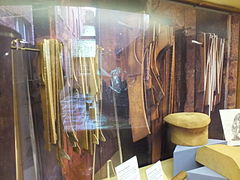Hat mold maker
The hat mold maker produces molds for the milliner and furrier trade and the corresponding industries, so-called hat blocks and muff blocks, with the help of which these trades produce headgear and muffle .
Hats , caps, caps and muffs often have rounded shapes that cannot be perfectly made by cutting and sewing alone. For these cases, the hat mold maker prepares the corresponding models made of wood, wood, metal or other materials, either according to the client's specifications or according to their own designs. Quickly made by moisture, the milliner or furrier stretches felt , leather or fur over the mold and lets the material dry on it.
The hat mold maker on the one hand needs precise knowledge of wood technology, on the other hand he has to know about metal processing.
In 1983 there were three workshops in the GDR that made hat shapes. The training period for the hat mold maker was two years. At the time, a colleague from Leipzig stated that he needed from one day to 14 days (for complicated metal molds) to produce a mold. With the band saw he cut out the basic shape for the block of wood from a plank, with the hand saw he gave it the almost future shape. The exact fine work was done with a milling cutter , chisel , rasp , file and the so-called bast ring, a kind of plane. For each shape, he made a plaster duplicate that was kept for as long as the model was still needed in production.
The edges of the hat are sawn with a scroll saw. The form is broken down into five parts and glued again to form a block that is free of distortion, or it is put together so that it can be taken apart. The split mold can be removed after the garment has dried without damaging it.
The milliner or a furrier tension the materials to be processed with pins , nails or purpose tacks on the form found today mostly with staplers and staples . For the industrial hat production, the hat mold maker also produces a pressure device for the block, which holds the hat material and saves tugging (mainly for men's hats). Since the shape is not damaged in the process, as is the case with tipping, this increases the life of the block considerably. For particularly large production series, he makes permanent molds from aluminum . In order to produce larger series quickly, the hat manufacturer needs several blocks of the same model, at times a significant investment if different shapes are required every season.
- William Plant, hat maker and woodworker in England ( Stockport Hat Museum )
Web links
- www.handarbeitswelt.de: How hat blocks are made (video, French with English subtitles) (last accessed January 6, 2013)
- Hat Works, Museum of the Hat Industry and Hat Fashion in Stockport, Cheshire, England (last accessed January 6, 2013)
Individual evidence
- ↑ www.drkoerner.net: Skilled trades in the GDR (as of 1990). Occupational group 34 wood (last accessed January 5, 2013)
- ↑ a b c Roch: Hat mold maker - a rare craft . In “Brühl” November / December 1983, VEB Fachbuchverlag Leipzig, pp. 30–31
- ^ Philipp Manes : The German fur industry and its associations 1900-1940, attempt at a story . Berlin 1941 Volume 2. Copy of the original manuscript, p. 23 ( G. & C. Franke collection ).





